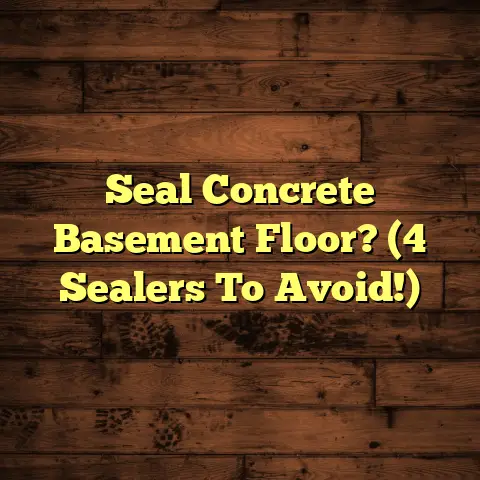Water Damaged Floor Repair Cost? (24 Hr Fix Alert!)
Let’s face it: our floors take a beating.
Day in and day out, they endure our footsteps, furniture scrapes, and the occasional spilled drink.
Over time, this wear and tear is inevitable, and sometimes, it’s not just the usual scratches we’re dealing with.
Water damage is a HUGE issue, and it can turn a small problem into a major headache – and a costly one at that.
I’m talking warped wood, bubbling laminate, and even mold growth (yuck!).
That’s why I’m here to give you the lowdown on water-damaged floor repair, specifically focusing on why you need to act FAST – ideally within 24 hours.
Trust me, the sooner you tackle this, the less you’ll spend in the long run.
So, let’s dive in and get you equipped with the knowledge to protect your flooring investment!
Section 1: Understanding Water Damage
Definition of Water Damage
Okay, so what exactly is water damage?
Basically, it’s any harm to your flooring caused by excessive moisture.
This can come from a variety of sources, like leaky pipes, overflowing toilets, burst water heaters, or even just a really bad storm that causes flooding.
According to the EPA, leaks account for more than 1 trillion gallons of water wasted each year in U.S. homes. (Source: EPA WaterSense)
And where does that water often end up? Yep, you guessed it – soaking your floors.
The effects can range from minor discoloration to severe structural damage, depending on the amount of water and the type of flooring you have.
Types of Flooring Affected
Now, let’s talk about the different types of flooring and how they react to water.
-
Hardwood: This is a classic, but it’s also pretty susceptible to water damage. It can warp, cup, buckle, and even rot if exposed to moisture for too long.
-
Laminate: Laminate is more water-resistant than hardwood, but it’s not waterproof.
Water can seep into the seams and cause the core to swell and bubble.
-
Tile: Tile itself is waterproof, but the grout lines aren’t. Water can penetrate through the grout and damage the subfloor.
-
Carpet: Carpet is like a sponge – it soaks up water like crazy. This can lead to mold and mildew growth, which is not only gross but also a health hazard.
-
Vinyl: Luxury vinyl plank (LVP) and sheet vinyl are among the most water-resistant options. They can handle spills and moisture pretty well, but standing water can still cause issues over time.
The severity of the damage really depends on the material. Hardwood and carpet are generally the most vulnerable, while tile and vinyl offer better protection.
Signs of Water Damage
How do you know if you have water damage?
Here are some key signs to look out for:
-
Warping: This is when your flooring starts to bend or curve. It’s common in hardwood and laminate.
-
Discoloration: Water can stain your flooring, leaving behind dark spots or a general faded appearance.
-
Bubbling: This is when the surface of your flooring starts to lift and form bubbles. It’s common in laminate and vinyl.
-
Mold Growth: If you see black or green spots, or smell a musty odor, you likely have mold. This is a serious issue that needs to be addressed immediately.
-
Soft Spots: If you step on an area of your floor and it feels soft or spongy, that’s a sign that the subfloor is water-damaged.
-
Peeling: Vinyl or linoleum floors may start to peel away from the subfloor.
Pro Tip: Don’t ignore these signs! The sooner you identify water damage, the easier and cheaper it will be to fix.
Section 2: Cost Factors in Water Damaged Floor Repair
Okay, let’s get down to brass tacks – how much is this going to cost you?
The price of repairing water-damaged flooring can vary widely depending on several factors. Let’s break them down.
Initial Assessment
The first step is to figure out the extent of the damage. This usually involves hiring a professional to come and inspect your floors.
The cost of an initial assessment can range from $100 to $500, depending on the complexity of the inspection and the company you hire.
Some companies may offer a free inspection, but be sure to ask about any hidden fees or obligations.
A thorough inspection is crucial because it will determine the best course of action.
They’ll check for moisture levels, assess the damage to the subfloor, and identify any potential mold growth.
Type of Flooring
As I mentioned earlier, different types of flooring react differently to water, and this affects the repair costs.
Here’s a general idea of what you can expect:
-
Hardwood:
- Repair: $300 – $1,000 (for minor damage)
- Replacement: $6 – $12 per square foot
-
Laminate:
- Repair: $200 – $800 (for minor damage)
- Replacement: $2 – $5 per square foot
-
Tile:
- Repair: $150 – $500 (for grout repair or replacing a few tiles)
- Replacement: $5 – $15 per square foot
-
Carpet:
- Repair: $100 – $400 (for cleaning and drying)
- Replacement: $3 – $8 per square foot
-
Vinyl:
- Repair: $100 – $500 (for patching or seam repair)
- Replacement: $2 – $7 per square foot
These are just averages, of course.
The actual cost will depend on the specific type of material, the quality, and the complexity of the installation.
Extent of Damage
The severity of the water damage is a major factor in determining the repair costs.
-
Minor Damage: This might involve a small spill that’s cleaned up quickly and only affects a small area.
In this case, you might only need to clean and dry the affected area, or replace a few planks or tiles.
-
Moderate Damage: This could be from a leaky pipe or a larger spill that soaks into the subfloor.
You might need to remove and replace some of the flooring, as well as dry out the subfloor.
-
Severe Damage: This is when you have extensive flooding or a long-term leak that causes significant structural damage and mold growth.
In this case, you’ll likely need to remove and replace all of the flooring, repair the subfloor, and remediate the mold.
For example, I once had a client who ignored a small leak under their sink for months. By the time they called me, the hardwood floor in their kitchen was completely rotted, and the subfloor was infested with mold. The total cost to repair the damage was over $10,000!
Labor Costs
Labor costs can also vary depending on your location and the complexity of the job.
In general, you can expect to pay $50 to $100 per hour for a qualified flooring specialist.
Some contractors may charge a flat rate for the entire job, which can be a good option if you want to know the total cost upfront.
Keep in mind that labor costs can be higher in urban areas or in areas with a high demand for skilled tradespeople.
Section 3: Urgency and Timing of Repairs
24-Hour Fix Alert
Okay, this is where I really want to drive home the importance of acting fast.
Water damage is like a ticking time bomb.
The longer you wait to address it, the worse it will get, and the more it will cost.
Ideally, you should start the repair process within 24 hours of the incident.
Why? Because water can quickly seep into the subfloor, causing structural damage and creating a breeding ground for mold.
Mold can start to grow within 24 to 48 hours of water exposure, and it can be very expensive to remediate.
Plus, the longer the water sits, the more likely it is to warp, buckle, or rot your flooring.
Emergency Services
If you have a major water damage situation, like a burst pipe or a flood, you may need to call for emergency water damage restoration services.
These companies are available 24/7, and they can quickly come to your home to extract the water, dry out the affected areas, and prevent further damage.
Emergency services can be expensive, typically costing $300 to $700 for the initial visit, plus additional charges for water extraction, drying, and dehumidifying.
However, the cost is often worth it to prevent further damage and minimize the risk of mold growth.
When you call for emergency assistance, be sure to ask about their response time, their experience, and their insurance coverage.
Section 4: DIY vs. Professional Repairs
DIY Repairs
If the water damage is minor, you may be able to tackle the repairs yourself.
For example, if you have a small spill on a hardwood floor, you can try cleaning and drying it with a soft cloth and a fan.
You can also use a dehumidifier to remove excess moisture from the air.
For laminate flooring, you can try carefully removing the affected planks and replacing them with new ones.
However, be careful not to damage the surrounding planks or the subfloor.
DIY repairs can save you money, but they also come with risks.
If you don’t properly dry out the affected area, you could end up with mold growth or structural damage.
Plus, if you make a mistake, you could end up making the problem worse and costing yourself even more money in the long run.
Professional Repairs
Hiring a professional flooring contractor has several advantages.
First, they have the expertise and experience to properly assess the damage and determine the best course of action.
Second, they have access to specialized equipment, like moisture meters, dehumidifiers, and mold remediation tools.
Third, they can provide warranties on their work, which can give you peace of mind.
While professional repairs are more expensive upfront, they can save you money in the long run by preventing further damage and ensuring that the job is done right the first time.
Plus, a professional can often spot hidden problems that you might miss, like mold growth behind walls or under cabinets.
Section 5: Total Cost Breakdown and Conclusion
Comprehensive Cost Breakdown
Okay, let’s put it all together.
Here’s a comprehensive breakdown of the total costs involved in repairing water-damaged flooring:
| Cost Category | Average Cost Range |
|---|---|
| Initial Assessment | $100 – $500 |
| Water Extraction | $300 – $700 |
| Drying & Dehumidifying | $200 – $500 |
| Flooring Repair | $100 – $1,000+ |
| Flooring Replacement | $2 – $15+ per sq ft |
| Mold Remediation | $500 – $5,000+ |
| Labor Costs | $50 – $100 per hour |
Note: These are just estimates.
The actual cost will depend on the specific circumstances of your situation.
Conclusion
So, there you have it – a comprehensive guide to water-damaged floor repair costs.
I hope this has been helpful and informative.
Remember, the key takeaways are:
-
Water damage is a serious issue that needs to be addressed quickly.
-
The cost of repairs can vary widely depending on the type of flooring, the extent of the damage, and the labor costs in your area.
-
Acting within 24 hours can significantly reduce the risk of further damage and minimize the overall cost.
-
DIY repairs can save you money, but they also come with risks.
-
Hiring a professional flooring contractor can ensure that the job is done right the first time and prevent future problems.
Stay vigilant about the signs of water damage, and don’t hesitate to take action if you suspect a problem.
Your floors will thank you for it!





